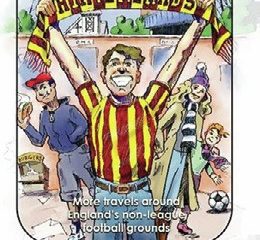
JOHN LYONS reviews the latest books to reach us at Late Tackle…
GRANDAD – WHAT WAS FOOTBALL LIKE IN THE 1960S?, BY RICHARD CROOKS, PUBLISHED BY DB PUBLISHING, £12.99
RATING OUT OF 10: 7
THE name of this book gives you a good indication of what’s in store – and it’s a fascinating look back to the ‘swinging sixties’.
It opens with an account by author Richard Crooks of his grandson Charlie’s first match – Reading v Sheffield Wednesday in 2014.
Fortunately for Wednesday fan Charlie, the Owls came away with a 2-0 victory to mark his debut in style.
This got his grandad thinking about what football was like in the 60s and it soon becomes clear the football experience now to then is like chalk and cheese.
Back then travelling around the country was difficult, communications were limited and fans arrived early at a ground to nab the favourite spot on the terraces.
At the start of the decade the players were still restricted by the maximum wage and the power was all with the clubs. You could say the boot is on the other foot now…
Clubs all had real hard men – the likes of Ron Harris, Norman Hunter, Tommy Smith, Dave Mackay -and there were legendary managers like Sir Alf Ramsey, Bill Shankly, Don Revie and Jock Stein.
Crooks makes clear the Sheffield rivalry between the Owls and Blades and covers a wide array of topics. In one part he ranks clubs according to league position throughout the decade – Tottenham come out first with an average position of 4.9, closely followed by Everton with 5.3.
In similar style, he looks at who the top ranked managers were – and it was, surprisingly for me at any rate, Harry Catterick, who managed Sheffield Wednesday and Everton, who came out on top with 584 points in the decade, followed by Tottenham’s Bill Nicholson with 557 points and Burnley’s Harry Potts with 509 points.
One of my favourite stories in the book is Crooks’ account of the World Cup final – and particularly why he missed seeing England crowned champions for the only time in their history! (I won’t ruin it for you by telling you why…).
Fittingly, the book closes with an account of his first ever game – Sheffield Wednesday v Fulham in November 1964 – and he reveals why he’s never left a game early since.
If you witnessed the 60s and would like to reminisce, then this book is a good option. If you didn’t and want to get a feeling about how football has changed, it’s also worth considering.
It’s not going to top the best sellers’ list and it’s by no means perfect, but this book has got charm, enthusiasm and passion behind it. It’s a nice idea well executed.

TRAITOR FOR A DAY – MY ADVENTURE AT THE STAMFORD BRIDGE, BY VINCENZO FELICI, PUBLISHED BY URBONE PUBLISHING, 12 EUROS
RATING OUT OF 10: 6
YOU don’t have to be a professional footballer to grace the turf of a top club – just ask Vincenzo Felici.
The Italian pharmacist has put together a book about his magical day playing a match at Stamford Bridge, the home of Chelsea.
How did it come about? Well, the Juventus fan read a story in ‘UK Football, Please’, an Italian fanzine about British football.
A contributor told the story of how he had played a match at Fulham FC organised by charity Football Aid, which raises money through allowing fans the chance to play a match at a professional club.
That whetted Felici’s appetite and he decided that Chelsea was the club he wanted to play at, partly because they’d had two former Juventus players in Gianluca Vialli and Pierluigi Casiraghi.
The book then details his training for the big match and the unexpected problem he had to overcome to take part on his big day.
An ex-pro is assigned by Football Aid to each side for the match – and Felici was chuffed that former Chelsea left-back Scott Minto was the man chosen for his team.
One reason was the pep talk Minto gave him before the match, which completely changed his mood and inspired him.
There follows Felici’s account of the match. His team lose, but I’m not giving away too much by revealing that he scored a goal. There is, after all, a picture of him celebrating on the front cover of the book – and it’s difficult to imagine anyone looking happier!
This book is a bit of a mixed bag. I’m sure it’s much better in its original Italian. It’s obviously been hard work translating it into English.
But even if it’s sometimes a bit confusing, you can understand the general idea and Felici’s determination to get himself in the best possible shape for the biggest game of his life.
There are some pretty dull passages – for example, the review of Chelsea’s history – but the book is at its best when the author is talking about his love for football, game preparations and the match itself.
It’s about someone with a dream – and battling to make that dream come true. And we can all relate to that.



Book Reviews
Book Review: Chris Towers finds right mix

Book Reviews
Book Review: Sir Geoff Hurst hits net











